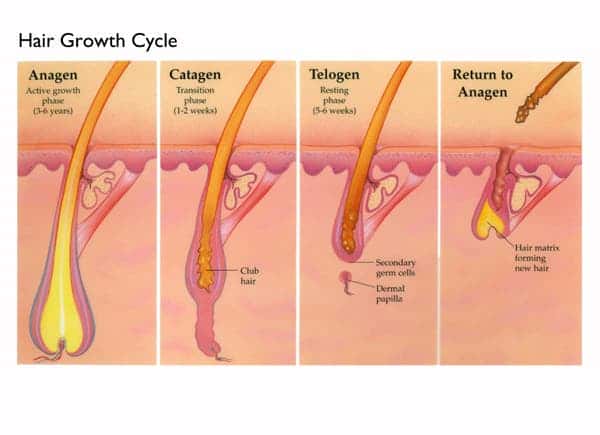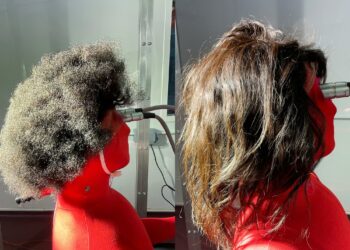
Have you ever wondered how swiftly your hair grows? On average, your scalp hair grows 0.35 to 0.45 millimeters a day — that’s half an inch per month.
Depending on your ancestry (genetics), diet, and hormonal state (pregnant women grow hair a bit faster; it’s also thicker and shinier), your hair will grow at a higher or lower rate.
Does thick hair grow faster?
There’s an age-old belief that thick hair grows faster than its thinner counterparts. But is there any truth to this notion? Let’s unravel this mystery.
When it comes to hair growth, thickness and speed sound like they should be two separate entities. The rate at which hair grows is primarily determined by your genetics, rather than its thickness. Each individual hair follicle has its own unique growth cycle, with three distinct phases: the anagen (growth), catagen (transition), and telogen (resting) phases.
During the anagen phase, which typically lasts between two to seven years, your hair follicles are actively producing hair. The length of this phase determines how long your hair can grow. In comparison, the catagen and telogen phases are shorter, lasting only a few weeks or months, during which hair growth ceases, and the old hair is shed to make way for new growth.
While the rate of hair growth is similar for both thick and thin hair, thicker hair might give the illusion of growing faster due to its increased volume. Even so, a 2015 study of nearly 60,000 people found thinner hairs grew slower than thicker hair. Furthermore, people with patterned hair loss showed slower hair growth rates — and this was true for both males and females.
It seems like there may be truth to this myth after all.
Does armpit hair grow faster than head hair? How about pubic hair?
Ah, the age-old debate—does the hair under your arms grow faster than the strands atop your head? Let’s put this myth to rest once and for all.
Contrary to popular belief, there is no substantial scientific evidence to support the claim that armpit hair grows at a faster rate than the hair on your head. While the growth rate of hair varies slightly from person to person, the disparity between these two areas is negligible.
The idea that armpit hair appears to grow faster could be attributed to several factors. Firstly, the proximity of the hair follicles to the skin surface in the armpit region can make the regrowth more noticeable, creating an optical illusion of rapid growth. Additionally, the shorter length of armpit hair, compared to head hair, might give the impression of a faster growth rate.
How Fast Does Body Hair Grow?

Forget about your armpits for a second. Let’s look at the grander picture.
All hair grows at exactly the same rate of about 0.3 mm a day or 1.25 centimeters per month, regardless of the body part. The main difference between scalp and body hair is the duration of growth. While hair on your head can grow for two to six years, the hair on your armpits, legs, and pubic areas stops growing after three to six months.
Interestingly, certain factors can influence the growth rate of body hair. Hormonal changes, such as those occurring during puberty or pregnancy, can stimulate hair growth in specific regions. Additionally, certain medical conditions or medications may affect the growth cycle, leading to either increased or decreased hair growth.
Why do we have hair in the first place?

The human body contains approximately 5,000,000 hair follicles, each responsible for producing a hair shaft. Our early ancestors were extensively covered in hair, serving various purposes such as heat conservation, protection from the sun, and camouflage. However, humans today stand apart from the 5,000 mammal species due to their nearly hairless appearance. This prompts the question: why did humans lose their body hair?
Scientists propose that our lineage has gradually become less hairy over the past six million years since diverging from our closest relative, the chimpanzee. While our ape ancestors resided predominantly in cool forests, a furry, upright hominid roaming under the sun would have risked overheating. One prevailing theory regarding our lack of fur suggests that temperature regulation played a pivotal role. Uncovered skin allows for the dissipation of body heat through sweating, a crucial adaptation as early humans adopted bipedalism and developed larger brains compared to their ape-like predecessors.
Nina Jablonski, an anthropology professor at Pennsylvania State University, argues that there must have been significant evolutionary pressure to control temperature in order to preserve the functionality of a larger brain. “We can now strongly argue that temperature regulation was the primary reason for our loss of hair over a million years ago,” she stated.
“The most plausible hypothesis suggests that we shed most of our body hair as an adaptation to improve heat dissipation, in other words, for thermal regulation,” Professor Jablonski explained at a American Association for the Advancement of Science meeting in Boston.
She further emphasized that humans became proficient sweaters as a result, shedding most of their hair and increasing the number of eccrine sweat glands on their bodies.
Apart from heat regulation, the reduction of body hair may have also resulted from a decreased infestation of parasites, such as ticks, lice, and biting flies. These ectoparasites can carry diseases caused by viruses, bacteria, and protozoa, including malaria and sleeping sickness, leading to severe chronic illnesses and even death. Through the utilization of fire and clothing, humans were able to minimize parasite infestation without suffering from the cold during the night or in colder climates.
Although humans are susceptible to head lice, it is likely that we retained head hair for protection from the sun and insulation in cold weather. Pubic hair, on the other hand, may have been retained due to its role in enhancing pheromones or the airborne odors of sexual attraction.
Hair in the armpits and groin acts as a dry lubricant, allowing for smooth movement of the arms and legs without chafing. Additionally, eyelashes serve as the first line of defense against bugs, dust, and other irritants.
However, most of the remaining body hair is considered superfluous and has been discarded. It’s important to note that humans haven’t completely shed their fur. We possess the same density of hair follicles on our skin as a similarly sized ape. If you examine your hands or feet, you’ll notice they are covered in hair, although it is so fine that it is barely visible.
How does hair grow?
Hair, whether on the scalp or elsewhere, originates from small pockets in the skin known as follicles. Hair growth begins from the base of these follicles called the root, which consists of cell proteins. These proteins receive nourishment from blood vessels that are scattered across the scalp.
As new cells are generated, the hair gradually grows in length, passing an oil gland along its path. Eventually, the hair shaft emerges from the opening of each follicle. By the time the hair becomes long enough to extend beyond the skin’s surface, it is already lifeless, which explains why you don’t feel any sensation when getting a haircut.
The hair shaft itself is composed of a tough protein called keratin. It consists of three primary layers. The innermost layer is known as the medulla, followed by the cortex, and the outermost layer is called the cuticle. Both the cortex and the medulla contain the pigments that give the hair its color.
Some quick facts about hair
- You are born with all the hair follicles you’ll ever have, totaling around 5 million. Approximately 100,000 of these follicles are found on your scalp.
- The hair on your head grows at a rate of about 6 inches per year. Interestingly, the only part of the human body that grows faster is bone marrow.
- Males tend to experience faster hair growth compared to females, primarily due to the presence of testosterone.
- On a daily basis, you may lose between 50 to 100 strands of hair. This occurs because hair follicles undergo cycles of growth for a certain period, followed by a resting phase. Follicles are not synchronized in their growth cycles, so some take a break (resulting in hair fall), while the majority continue their normal growth.
- As individuals age, certain hair follicles may cease to grow, leading to thinning hair or baldness in older people.
- Each person’s hair is unique, characterized by its texture, which can be straight, wavy, curly, or kinky, as well as its thickness (thin or thick) and coarseness (fine or coarse). These traits are determined by genetics, specifically the shape of the hair follicles. For example, oval-shaped follicles tend to produce curly hair, while round follicles result in straight hair.
- Similar to skin, hair exhibits a range of colors influenced by a pigment called melanin. The quantity of melanin in your hair determines its darkness or lightness. As you age, the production of melanin decreases, causing hair to lose color and potentially appear gray.
The hair growth cycle
Follicles go through three phases: anagen (growth), catagen (preparation for rest), and telogen (rest and hair shedding). Each strand of hair on your scalp transitions through these phases at its own pace.
- Anagen: In this phase, cells inside the hair follicle’s root undergo rapid division. New hair is formed, pushing out old hair that has stopped growing or is no longer in the anagen phase. During this phase, scalp hair grows approximately 1 cm every 28 days. The anagen phase for scalp hair lasts for two to six years, while the hair on other parts of the body, such as arms, legs, eyelashes, and eyebrows, has a much shorter active growth phase of about 30 to 45 days. This is why these hairs are significantly shorter than scalp hair. Moreover, individuals may have varying lengths of the anagen phase for a specific body part due to their genetics. On average, the anagen phase for scalp hair lasts about 2-7 years.
- Catagen: This phase accounts for approximately 3% of all the hair on your body at any given time. It lasts for two to three weeks, during which growth stops. The hair follicle in this phase undergoes a shrinkage to about 1/6 of its original length.
- Telogen: Around 6 to 8 percent of all your hair is in the telogen phase, also known as the resting phase. If you pull out a hair in this phase, you will observe a solid, hard, dry, white material at the root. On a daily basis, it is normal to shed between 100 to 150 hairs. This shedding is a regular part of the hair growth cycle and indicates a healthy scalp. Excessive hair loss should be a cause for concern, and it is advisable to seek medical advice in such cases.
Why does hair only grow to a certain length?
Each hair grows from a follicle, and as the hair becomes longer and heavier, the follicle eventually reaches its limit and sheds the hair. However, this is a natural process, and new hair starts growing in its place. The maximum length to which you can grow your hair depends on your genetics. In general, Asians tend to be able to grow their hair longer than Europeans. It may come as a surprise, but just like in other mammals, each person has a genetically predetermined hair length limit.
The potential hair length is often the longest in individuals with round follicles, as round follicles have a better grip on the hair. Therefore, people with straight hair have the potential to grow their hair longer, while shorter hair is associated with flat follicles. A study published in 2007 found that Japanese and Chinese individuals have thicker hair because their follicles are approximately 30% larger than those of Africans and 50% larger than those of Europeans.
In most cultures, women tend to keep their hair longer than men. Apart from cultural norms, there is a natural sexual dimorphism in hair length. Generally, women have the ability to grow their hair longer compared to males.
For European males, the maximum length for wavy hair is typically around shoulder length, while the maximum length for straight hair is approximately mid-back length. On the other hand, European females with wavy hair can often grow it to reach the waist, while straight hair can extend to the buttocks or even longer.

How to grow your hair faster and longer
While genetics caps your hair length, it is possible to accelerate its growth rate.
- Prioritize your overall body health, as it directly impacts hair growth. Include marine proteins, vitamin C-rich foods (such as red peppers), zinc sources (like oysters), biotin (found in eggs), niacin (abundant in tuna), and iron (available in oysters) in your diet to nourish your hair.
- If dietary changes are challenging, consider supplements containing marine extracts, vitamins, and minerals that specifically support hair follicles.
- Pay attention to your scalp health. Use a gentle shampoo that exfoliates oil and debris from the scalp, and follow up with a moisturizing conditioner to nourish both the scalp and hair.
- While trimming hair does not directly promote growth, it helps prevent breakage, which can result in longer hair over time.
Things that actually hurt your hair:
- Silicone shampoos can dry out and degrade hair. Similarly, excessive use of blow dryers and flat irons can cause damage by breaking the hair shafts. Minimize the usage of these products whenever possible.
- UV light from the sun can bleach and weaken hair. When exposed to sunlight, protect your scalp by wearing a hat.
- Saltwater and chlorinated water can both soften and dry out the hair. Rinse your hair thoroughly after swimming and consider using protective products before entering the water.
- Chemical treatments such as bleaching, dyeing, hair extensions, and perms can cause significant damage to the hair.








